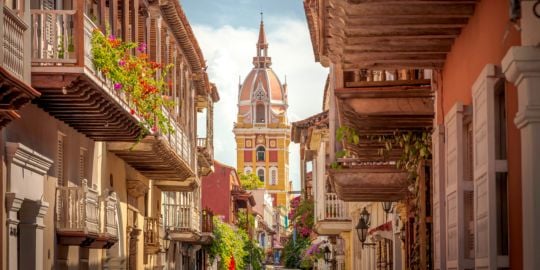Colombian Flower Trade
Colombia has long been recognised as one of the world’s top producers of Coffee. Here the growers mainly cultivate the smooth, richly flavoured arabica beans. These beans grown in ideal climate and soil conditions, have really put Colombia on the map for premium coffee, with coffee exports second only to Brazil.
Colombia also has one of the widest range of edible fruit in the world, many of which can be seen growing wild. The range available in the markets include 'exotic' fruit such as Maracuya, Guanabana, Mango, Lulo, Pitaya, Cherimoya, Guava and many many more equally delicious fruits. In Colombia, it is possible to enjoy a different, freshly squeezed fruit juice every day here for two weeks or more before having to repeat! More recently however a new industry has been quite literally shooting up and that is the cultivation of cut flowers for the world market. Colombia has historically had one of South America's most stable and diverse economies, and this even more so today. The country has economically grown every year in the past decade, and they do not have the debt problems of many of the other countries in Latin America.
Colombia exported more than two billion flower stems and 50 types of flowers to the U.S in 2006 totalling a staggering $418 million.The U.S. also imports 70% of its cut roses, 98% of its chrysanthemums and 99% of its carnations and Alstroemerias from Colombia. By 2012 this figure rose to a staggering US$1.188 billion. The United States is the most important market, with a 76.6% share of the total exports. Followed by Russia (5.4%), Japan (3.7%), the UK (3.4%) and Canada (2.8%). The number of growers also having increased in tandem, to more than 400. So too had the acreage of land under cultivation.
The country accounts for over one tenth of the world's flower exports, second only to Holland. Most of Colombian flower production however goes to the U.S and comprises four-fifths of its carnations and a third of its roses. Quantities of Colombian cut flowers are now being exported to countries in Europe, and are even seen in florist shops in the U.K.
Colombia's flower industry has become firmly established in the high, sunny plateaus outside of its two largest cities, Bogota and Medellin. Almost 6,000 hectares (14,826 Acres) of land in Colombia are dedicated to cut flower production -- generating 111,000 direct and 94,000 indirect jobs for Colombian men and women in new allied industries, such as packaging and transport. Sixty percent of the floral farm work force consists of women - many of them single mothers, who live and work in rural areas close to these large cities.
Mild temperatures, fertile soil, and long equatorial days help Colombia grow the roses throughout the year without expensive hot houses. The country also has an abundant supply of cheap labour as well.
Moreover, there is a vital 'spin-off' from this sector too as it helps reduce the need for production and trafficking of illegal drugs. With these types of results it is no wonder that the Colombian government and Colombian businesses are continually proposing plans for the expansion of this sector. Today, Colombia is the world's second largest exporter of cut flowers, with at least 10% share of the world's cut flowers exports. For example,in 2005, Colombia's flower exports worldwide were around $906 million.
During my various trips to Colombia, I was able to visit both 'La Bromelia,' which must be one of the largest bromeliad nurseries in the world, and one of Bogota's large markets named Paloquemao. Both of these were very clean and orderly. Apart from selling fruit meat fish and vegetables, a major section of Paloquemao is the flower market. Opening very early in the morning and closing down by 11.30am it is packed up and gone by noon.
If you happen to be looking for cut flowers however, this is the ideal place. Most types of flower, including the real tropical exotics such as heliconias, orchids and tropical water lilies (these are used as cut flowers in Colombia), plus gerbera, roses, daisies, carnations, alstroemeria etc are available. It is not just the variety of fruit that is amazing but also the size. Grapes for example are enormous. Just look at the size of these grapes compared to my hand! Avocados too seem to be 'On Steroids' being at least twice as large as those available in the U.K.
In the early 1990's Colombian growers came under criticism for the poor working conditions of the employees and heavy handed use of toxic insecticides. All that is changing now through the efforts of Asocolflores (the Colombian Association of Flower Exporters), which now represents over 75% of the countries flower growers. Ascolflores is dedicated to the promotion of sustainable flower growing, but also with an eye to social responsibilities. Asocolflores is rigorously promoting its Floraverde program, which is similar to the widely recognised Fairtrade initiative.
In 2003 for example, they set up the School of Floriculture, to give a better future to workers through training in flower growing. So far, over 1000 families have taken part in this training scheme, with another 1300 or so taking part by August 2008.
Floraverde member farms give welfare of worker high priority and some such as Faseflores are helping their workers to find housing, even building specially designed homes. These can be bought for around £5000 and the company even provides workers with 40% of the buying price under its 'Flowers are Home' programme.
All this means that in the next few years, the majority of flowers bought in the western world for use in the home or at work, will probably have been grown in this lovely and rapidly developing country.









